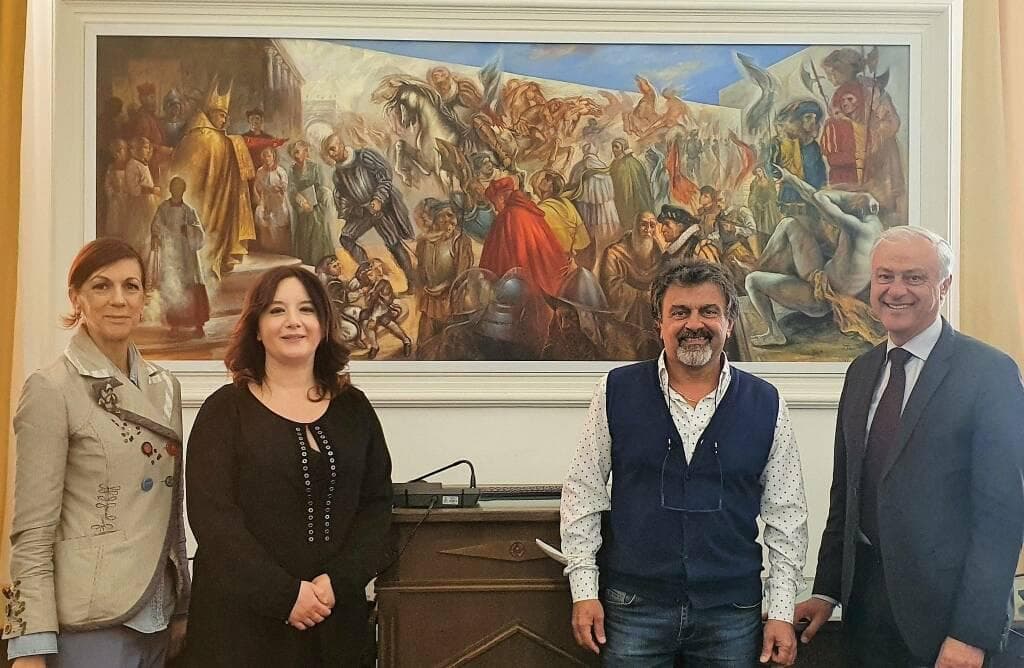La sfida del pittore Stefano Piali: raccontare la storia simbolo dell’identità occidentale in un ciclo di nove dipinti nella residenza del condottiero trionfatore.
On 7 October 1571 in the waters of Lepanto, in what is now called the Gulf of Corinth, the fleet of the Holy League defeated the Ottomans in a fearful advance towards Europe. A date that has become a commonly recognized symbol as the focal point of the modern definition of identity of the West. Or at least of that central-southern Europe that met, from Spain to Venice, under the blessing of Pope Pius V for what was considered the last great naval battle supported with galleys, rowing war boats. The crossing of boats in a reproach of sea waves depicted as a whirling proscenium, ready to challenge humans and boats. Waves that like streams of thought completely devoid of rhetoric and triumphalism, also want to represent the no longer postponable alarm bell for our world and our modern consciences that in the paintings often appear as gray figures, marginal to the focus of the painting , as if lost in the despair of those who ignore. This is the recurring theme and sentiment in the monumental cycle of works that the master Stefano Piali, a Roman painter and sculptor, has been undertaking for a year: adorning the walls of the noble floor of Palazzo Colonna in Marino (Rome) with icastic and crusade scenes. which saw Marcantonio Colonna, one of the protagonists of the war enterprise. Piali has been working for a year on this project entrusted to him by the local municipal administration on the occasion of the 450th anniversary of the Battle of Lepanto. In reality, this commission starts from further away. Twenty years ago, in fact, a very large painting was placed in the same building, again by Piali, depicting the return from Lepanto. Today, twenty years later, this cycle will complete the story we have called Journey into the history of the Colonna in collaboration with the students of the Art School of the I.I.S.Amari-Mercuri. That of Marino is the residence of the noble family that in the Castelli Romani fiefdom saw ideally pass the baton a genius like the poetess Vittoria Colonna, spiritual companion of Michelangelo Buonarroti, wife of the Spanish commander Ferrante d'Avalos and, a few decades later, the Prince Marcantonio II who was the leader of the Lepanto enterprise by direct emanation of the Pope. And this scene too is included and immortalized in one of the nine works, recalling in a central point of the hall, the blessing of Pope Pius V to Marcantonio , appointed commander of the papal troops on 11 June 1570. It must be said that the master Piali, who, moreover, in the very ancient way, in the installation of these nine representations, also wanted to involve the students of the final classes of the local artistic high school, in turn takes the moves from illustrious names such as Vasari or Veronese who, on the theme of the battle of Lepanto, measured themselves against works now exhibited respectively in the Sala Regia in the Vatican, at the entrance to the Sistine Chapel and in the gallery of the Venetian Academy. In recent days the third representation was placed, to act as a counterbalance to that of the papal blessing, entitled The dignity of the Moor before the inevitable epilogue, a painting in which the Turkish prisoner is depicted in a pose of still human suffering, as in the moment before the victors could fully dispose of his fate. Piali's story in images will last at least another two years, when the work will be completed as a tribute to the memory of days as memorable as, in fact, never lost from the narration of what we like to call actuality.
 Photo of the event
Photo of the event
 Photo of the event
Photo of the event